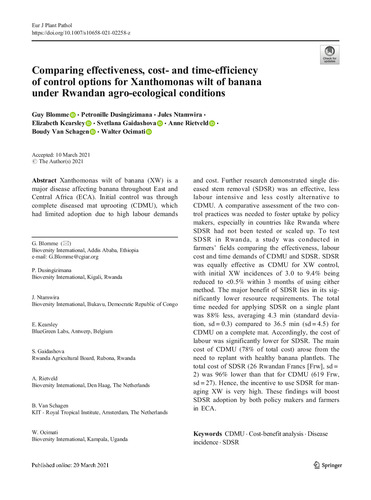Comparing effectiveness, cost- and time-efficiency of control options for Xanthomonas wilt of banana under Rwandan agro-ecological conditions
Xanthomonas wilt of banana (XW) is a major disease affecting banana throughout East and Central Africa (ECA). Initial control was through complete diseased mat uprooting (CDMU), which had limited adoption due to high labour demands and cost. Further research demonstrated single diseased stem removal (SDSR) was an effective, less labour intensive and less costly alternative to CDMU. A comparative assessment of the two control practices was needed to foster uptake by policy makers, especially in countries like Rwanda where SDSR had not been tested or scaled up. To test SDSR in Rwanda, a study was conducted in farmers’ fields comparing the effectiveness, labour cost and time demands of CDMU and SDSR. SDSR was equally effective as CDMU for XW control, with initial XW incidences of 3.0 to 9.4% being reduced to <0.5% within 3 months of using either method. The major benefit of SDSR lies in its significantly lower resource requirements. The total time needed for applying SDSR on a single plant was 88% less, averaging 4.3 min (standard deviation, sd = 0.3) compared to 36.5 min (sd = 4.5) for CDMU on a complete mat. Accordingly, the cost of labour was significantly lower for SDSR. The main cost of CDMU (78% of total cost) arose from the need to replant with healthy banana plantlets. The total cost of SDSR (26 Rwandan Francs [Frw], sd = 2) was 96% lower than that for CDMU (619 Frw, sd = 27). Hence, the incentive to use SDSR for managing XW is very high. These findings will boost SDSR adoption by both policy makers and farmers in ECA.

